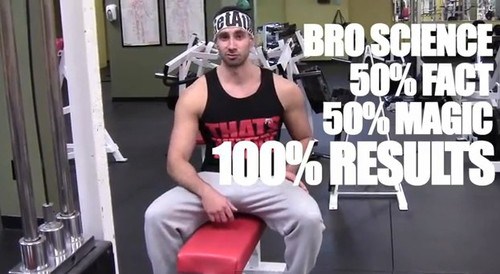Broscience

A few weeks ago, I took a look at science, and at how it should form the basis of fitness and health decision-making.
But in the fitness world, there’s ‘real science,’ and then there’s ‘bro science,’ which Urban Dictionary defines as “the predominant brand of reasoning in bodybuilding circles, where the anecdotal reports of jacked dudes are considered more credible than scientific research.”
Oh, bros. Thinking they know stuff!
But it turns out, they actually do know some stuff.
Sometimes, they even know stuff that’s not just correct, but actually ahead of the curve. Stuff that simply hasn’t yet been picked up and researched by (non-bro) scientists.
Consider a piece of bodybuilding wisdom that’s long been poo-pooed by the kinesiological establishment: that different movements hit different parts of the same muscle. For example, bodybuilders have long claimed that the regular bench press predominantly hits the outer pec, while flyes and close-grip bench presses are needed to pump the inner pec.
For years, physiologists explained that’s just not how muscles work. When you work out your pectoral muscle, you work out the whole thing. Your pec shape is largely genetic, and though you can make the muscle bigger, you’re only making it a bigger version of that genetically-determined shape.
More recently, however, research has shown that you actually can build different parts of the muscle preferentially. (Here’s a good review paper.) Muscles are made up of a number of different kinds of tissues, and even individual muscle cells have multiple nuclei across their lengths.
As the review puts it, “an individual muscle cannot be simplistically described as a compilation of muscle fibers that span from origin to insertion.” The review concludes, “electromyographic data indicate that there is selective recruitment of different regions of a muscle that can be altered, depending on the type of exercise performed. Longitudinal resistance-training studies also demonstrate that individual muscles as well as groups of synergist muscles adapt in a regional-specific manner.”
In other words, the bros were right.
So do we listen to the scientists, or do we listen to the meatheads?
My answer: you need to listen to both. At Composite, we scour the current published research to develop a base of practice. But we also follow trends from the in-the-trenches strength and conditioning community, to find new ideas that might be worth testing, too. From there, we take science in our own hands.
In the tech world, constant rigorous experimentation is nearly ubiquitous. If you’re running a Facebook ad, for example, you’d start with a handful of versions of an ad, and A/B test their click-through rates against each other, iteratively selecting the best performers, then testing them against similar variants based on those best performers to see if you can continue to incrementally tweak results.
The same thing works with fitness, too. By taking new ideas, whether from science science or bro-science, and structuring them into periodized cycles of implementation, we can test them head-to-head against our current best practices, within randomly-assigned portions of our client base. Because our workouts are heavily quantified, and because we track results-focused biomarkers, we can then empirically see what actually works.
From there, we can take the most successful approaches, make them our new best practices, and continue to evolve forward by testing additional new ideas.
Sure, all that testing takes a lot of work. As does keeping up with a slew of science journals, and with new on-the-ground innovations in the strength and training world. But we think the improved results yielded more than make up for the effort. As Bruce Lee put it: “Absorb what is useful. Discard what is not. Add what is uniquely your own.” That’s what Composite is all about.